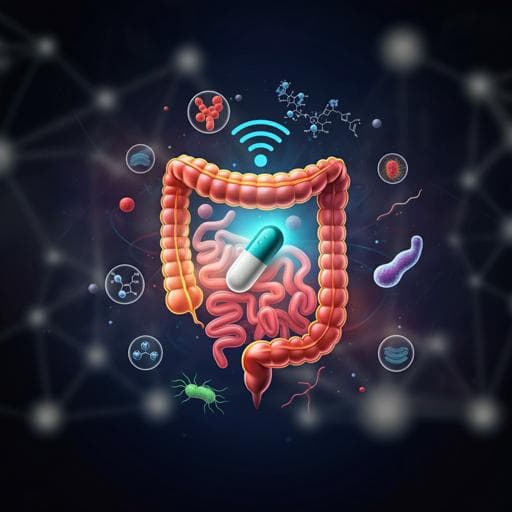
Medicine and Health
A self-powered ingestible wireless biosensing system for real-time in situ monitoring of gastrointestinal tract metabolites
E. D. L. Paz, N. H. Maganti, et al.
Discover the groundbreaking advancements in gastrointestinal health with a battery-free ingestible biosensing system developed by a team of researchers including Ernesto De La Paz, Nikhil Harsha Maganti, and Joseph Wang. This innovative technology enables real-time monitoring of metabolites in the small intestine, promising vital insights for diagnosing gastrointestinal disorders.
~3 min • Beginner • English
Introduction
Gastrointestinal (GI) disorders affect roughly one in five people and contribute substantially to healthcare burden. Gut microbiota-derived metabolites influence diseases, nutrition, obesity, and other physiological processes. Accessing and monitoring metabolites in the small intestine remain challenging; current approaches (stool tests, endoscopic fluid collection, breath testing) are invasive or lack real-time capability. Miniaturized ingestible devices have emerged for GI imaging, temperature, heart rate, pH, pressure, hemorrhage, and medication monitoring. Extending ingestible devices to measure intestinal metabolites in situ could improve diagnosis and treatment of conditions such as IBD, diabetes, and obesity. This work aims to enable real-time, in situ monitoring of intestinal metabolites by demonstrating a battery-free ingestible biosensing capsule that self-powers from glucose and transmits data wirelessly from within the small intestine.
Literature Review
Prior ingestible technologies include wireless capsule endoscopy for imaging, devices for core temperature monitoring, heart rate, pH, pressure, and hemorrhage detection, and adherence monitoring. Biosensing in the GI tract has been shown using bacterial-based luminescent biosensors for bleeding biomarkers and capsule-based gas sensors for inflammatory markers and diet-related gases. Despite these advances, direct, real-time quantification of metabolites (e.g., glucose) in the distal GI tract remains limited, often relying on invasive sampling or indirect tests. Energy harvesting approaches (e.g., biofuel cells, wearable bio-supercapacitors) and low-power communication methods such as magnetic human body communication (mHBC) have advanced, suggesting feasibility for battery-free ingestible biosensors. Pigs are an established preclinical model for GI studies and glucose absorption dynamics, supporting translational relevance.
Methodology
Device architecture: A glucose biofuel cell (BFC) acts as both the power source and the glucose sensor, integrated with a custom ultra–low-power ASIC that converts BFC voltage into a transmission frequency for wireless telemetry via magnetic human body communication (mHBC). The capsule includes pH-responsive enteric coatings to protect during gastric transit and activate in the neutral pH of the small intestine.
Custom integrated circuit (IC): The ASIC forgoes DC-DC boost conversion and operates directly from the low-voltage BFC. It consumes ~0.4 µW average power and uses a voltage-to-frequency conversion scheme. Operation is duty-cycled in two phases: (1) S1 connects BFC to charge an energy buffer capacitor C0 powering a low-frequency VCO (≈1–2 Hz) to time transmissions; (2) On pulse (φ1), S2 is off and S3 connects the BFC to Rbreak to generate Vtrack, powering a VCO that produces a 10 kHz–1 MHz signal to modulate an LC mHBC power oscillator. The chip was fabricated in 180 nm CMOS and mounted on a 16.4 × 7.5 mm PCB with an on-board mHBC antenna. Calibration exhibited a quadratic voltage-to-frequency relationship.
Electrode and BFC fabrication: Porous nickel foam electrodes were formed into cylindrical spirals and coated with a carbon-based slurry (MWCNT-COOH, mesoporous carbon, SEBS-MA). The anode and cathode were modified with mediators (TTF-TCNQ for anode; ABTS for cathode), followed by enzymatic functionalization with glucose oxidase (GOx) at the anode and bilirubin oxidase (BOD) at the cathode. Chitosan films stabilized the biolayers. Electrodes were conditioned by cyclic voltammetry in PBS.
Capsule fabrication and enteric protection: A two-piece 3D-printed resin capsule (≈0.9 cm diameter, 2 cm length) housed the electronics and BFC. The device was insulated with polyurethane and a biocompatible elastomer. A pH-responsive enteric coating (Eudragit L100) was applied in multiple layers; three layers were identified as necessary to protect in gastric fluid (pH ~1.5–1.8) and dissolve in intestinal pH (~6.8), activating the BFC.
In vitro electrochemical and environmental characterization: BFC performance was assessed across pH 6.1–8.5 (small intestine-relevant), oxygen partial pressures (by nitrogen purging; measurements at pH 6.8), and temperatures (35, 37, 39 °C). With 30 mM glucose, BFC operating potential decreased from 0.575 to 0.503 V with extended nitrogen purging; cathode chronoamperometry vs oxygen showed minimal differences (±4 mV) between tested O2 levels. Temperature affected signal increments; 37 °C was used for subsequent tests. Quadratic calibration across 0–110 mM glucose gave R² = 0.991.
In vitro flow system and wireless readout: A peristaltic pump delivered artificial intestinal fluid (AIF) with controlled glucose concentrations at 3 mL/min for 5 min, followed by 10 min static contact; measurements were recorded wirelessly via mHBC using an oscilloscope-based receiver and custom processing. Conditions: 37 °C, ~2% O2 (nitrogen purged). The system simulated intermittent exposure to varying glucose levels. Interference tests included lactic acid (0.1 mM), ascorbic acid (0.1 mM), uric acid (0.1 mM), and sodium cholate (3 mM). Biofouling resilience was assessed using AIF with artificial mucus components (polyacrylic acid, mucin, BSA, cholesterol, phosphatidylcholine).
In situ porcine experiments: Farm pigs (3–8 months; 42–50 kg) underwent oral gavage to place the capsule in the stomach (confirmed by X-ray), followed by fasting and a second X-ray to confirm intestinal location and enteric coat dissolution, after which wireless signals were recorded. Anesthesia included isoflurane and adjuncts; vital signs were monitored. Liquid saline-based glucose doses (e.g., 360 mL at 30 or 60 mM; some protocols included glucose-free saline) were administered at specified times. Blood glucose level (BGL) was measured every 20 min with a commercial meter. Intestinal glucose level (IGL) was computed from transmitted frequency using prior calibration. Data were sampled every 5 s and processed on a laptop receiver system.
Key Findings
- Ultra–low-power IC: Average power consumption ~0.4 µW; successful direct operation from BFC without DC-DC conversion; quadratic voltage-to-frequency characteristic validated across multiple boards (n=4).
- BFC environmental responses: pH 6.1–8.5 showed increased glucose response with higher pH; at pH 6.8 and 30 mM glucose, BFC operating potential decreased from 0.575 V to 0.503 V with nitrogen purging (oxygen dependence). Temperature affected signal; 39 °C produced smaller increments than 35–37 °C.
- Calibration and performance: Quadratic fit over 0–110 mM glucose gave R² = 0.991. Overall limit of detection (LOD) 4.656 mM; dynamic range 3–90 mM. Device frequency baseline in glucose-free AIF ≈75 kHz; 90 mM glucose increased frequency to ≈250 kHz, reversible upon washout.
- Power sufficiency: BFC provided sufficient power for telemetry across conditions, even at 0 mM glucose (due to electrode potential and oxygen reduction reactions).
- Enteric coating: Three layers of Eudragit L100 required to protect BFC in acidic gastric fluid and dissolve at intestinal pH, reliably activating the device post-stomach transit.
- Stability and interference: During 3 h retention at 60 mM glucose, frequency drift was minimal (≈4–7%). Interferents (0.1 mM lactic acid, 0.1 mM ascorbic acid, 0.1 mM uric acid, 3 mM sodium cholate) showed negligible cross-reactivity relative to glucose-free baseline.
- Biofouling tolerance: Artificial mucus components induced small changes (<10%) in response; diffusion differences affected response speed but not magnitude substantially.
- In vitro flow reversibility: Capsule transmitted reversible signals corresponding to alternating 0, 30, and 90 mM glucose exposures; calibration reproducible across devices.
- In situ porcine results: After confirming intestinal location by X-ray, the capsule reported IGL dynamics consistent with administered doses. Example findings: (i) 360 mL of 60 mM glucose elicited rapid IGL increase to a plateau reported around 20–22 (units as reported) by ~90 min, with BGL rising from ~65–70 mg/dL (fasted) upward; (ii) sequential 36 mL of 30 mM then 360 mL of 60 mM glucose produced IGL plateaus ~6 mM then ~12 mM; BGL increased from ~70 to ~170 mg/dL over 270 min; (iii) 360 mL 60 mM glucose followed by 360 mL glucose-free saline yielded IGL increase to ~16 mM then a delayed sharp decrease toward ~0 mM by ~300 min, with a transient semi-stable 4–6 mM around 180 min. These data indicate sensitivity to dosage and dilution, and demonstrate divergence and temporal offsets between IGL and BGL due to absorption and homeostasis.
- Noise and dynamics: In vivo frequency data showed higher noise than in vitro, likely due to intestinal motility (MMC) and digestion-related movements; applying low-pass filtering preserved concentration trends while reducing high-frequency noise.
Discussion
The study addresses the challenge of real-time, in situ monitoring of intestinal metabolites by integrating a glucose biofuel cell with an ultra–low-power ASIC and mHBC telemetry in a swallowable capsule. By eliminating a battery and DC-DC conversion, the system maintains a sub-microwatt power budget while harvesting energy from intestinal glucose and oxygen. In vitro, the BFC-based sensor showed high sensitivity, stability over hours, low interference from common compounds, and resilience to biofouling components. The enteric coating strategy enabled gastric protection and reliable activation in the small intestine. In situ porcine experiments confirmed that transmitted signals track changes in intestinal glucose following oral dosing and revealed expected differences in timing and magnitude between intestinal and blood glucose due to absorption and physiological regulation. Collectively, the results demonstrate feasibility of battery-free, wireless, real-time intestinal metabolite sensing and provide insights into glucose dynamics within the small intestine.
Conclusion
This work introduces a battery-free ingestible capsule that self-powers from a glucose biofuel cell and wirelessly transmits intestinal glucose data using mHBC. The system overcomes key barriers in ingestible biosensing, including power autonomy, miniaturized low-power electronics, trans-tissue telemetry, and protection from gastric conditions. Experiments validated sensitivity, stability, interference tolerance, and in situ responsiveness to dosing. Future efforts should miniaturize the capsule to commercial pill sizes, broaden sensing to additional analytes (e.g., pH, oxygen, electrolytes, drugs), refine calibration and signal processing (including motion/noise mitigation and optimized sampling), and evaluate performance under varied physiological conditions (including solid food). Such multifunctional, energy-autonomous platforms could deepen understanding of GI metabolism and aid diagnosis of malabsorption and other disorders.
Limitations
- In vivo noise likely from intestinal motility (migrating motor complex) and digestion-related movements; sampling rate may be higher than needed, suggesting potential for optimized acquisition and filtering.
- In vitro tests lacked mechanical motion present in vivo, limiting direct comparability of noise characteristics.
- In situ experiments were conducted without solid food; solid food was observed to decrease sensor response in separate data, indicating the need for dedicated studies under fed conditions with solids.
- Current prototype focuses on glucose sensing; broader multiplexed sensing and on-board calibration remain future work.
- Capsule dimensions are larger than some commercial ingestible devices; further miniaturization is required for broader applicability.
- Limited statistical analysis in in situ experiments; small sample scenarios and lack of blinding could affect generalizability.
Related Publications
Explore these studies to deepen your understanding of the subject.







